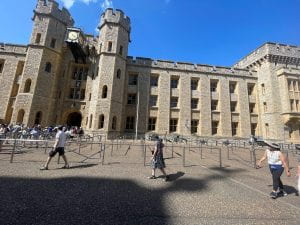The Koh-i-Noor diamond is held in the Tower of London, along with other crown jewels. The diamond has a long history in South Asia before it was taken by the British in 1849 from Duleep Singh. It was really interesting to see the diamond after learning how many people struggled for it and the claims being made for it now. There was a replica of the diamond closer to the front of the building and then the real diamond later in the exhibit. There were screens showing the context of the diamond, including all the places that it had been and how it got to Britain.
There is extensive recorded history of the diamond traveling through the hands of the Mughal dynasty, starting with Shah Jahan and his bejeweled throne. From there, the diamond lands in the hands of Nader Shah, a Persian ruler who invaded Delhi. The diamond traveled from present-day India to Afghanistan, and it remained there for 70 years. The diamond went through many kings and became cursed in the process.
Around 1813, the diamond returned to India in the hands of Rajit Singh, representing his power and capabilities. After four rulers had come and gone through the Punjab throne, Duleep Singh came to power at ten years old. Duleep was coerced to give up the diamond to the British East India Tea Company, and it was given to Queen Victoria.
Now, the diamond is displayed for the public to view in the Tower of London. The diamond was supposed to make an appearance in the most recent coronation of King Charles and Queen-Consort Camila, but it has been the subject of controversy among the number of contested items that Britain holds. There has been discussion of whether the diamond should return to India, and world leaders have stirred the media with their takes on the rightful place of the diamond.
In our class, we had a discussion about the best place for the diamond, which I found quite intriguing. There were concerns about how secure the diamond would be, where it would be displayed if it were to return to India, and whether it could be shared among nations. I think that these are all incredibly valid concerns and led to a successful discussion. However, this discussion needs to be initiated by world leaders rather than just making isolated statements to the media. The Koh-i-Noor diamond holds a lot of history and symbolism and deserves to be treated and discussed in a disciplined and honorable manner. No matter what other nations claim, Britain needs to take the first step in figuring out a fair solution. After all, it is their colonialism that led to the displacement of the diamond into the Western world.
While the diamond was incredibly beautiful and glamorous, it also reveals the very ugly parts of history. Historical items like this diamond should not be fought over but learned from. Sadly, Britain refuses to even have a conversation about the return of the diamond to South Asia. History is supposed to be a lesson for the future. Let the return of the Koh-i-Noor diamond be the start of this new chapter of history, in which we teach future generations about contested items and the return to their homes.
Sources:
https://www.bbc.co.uk/news/uk-64638152


